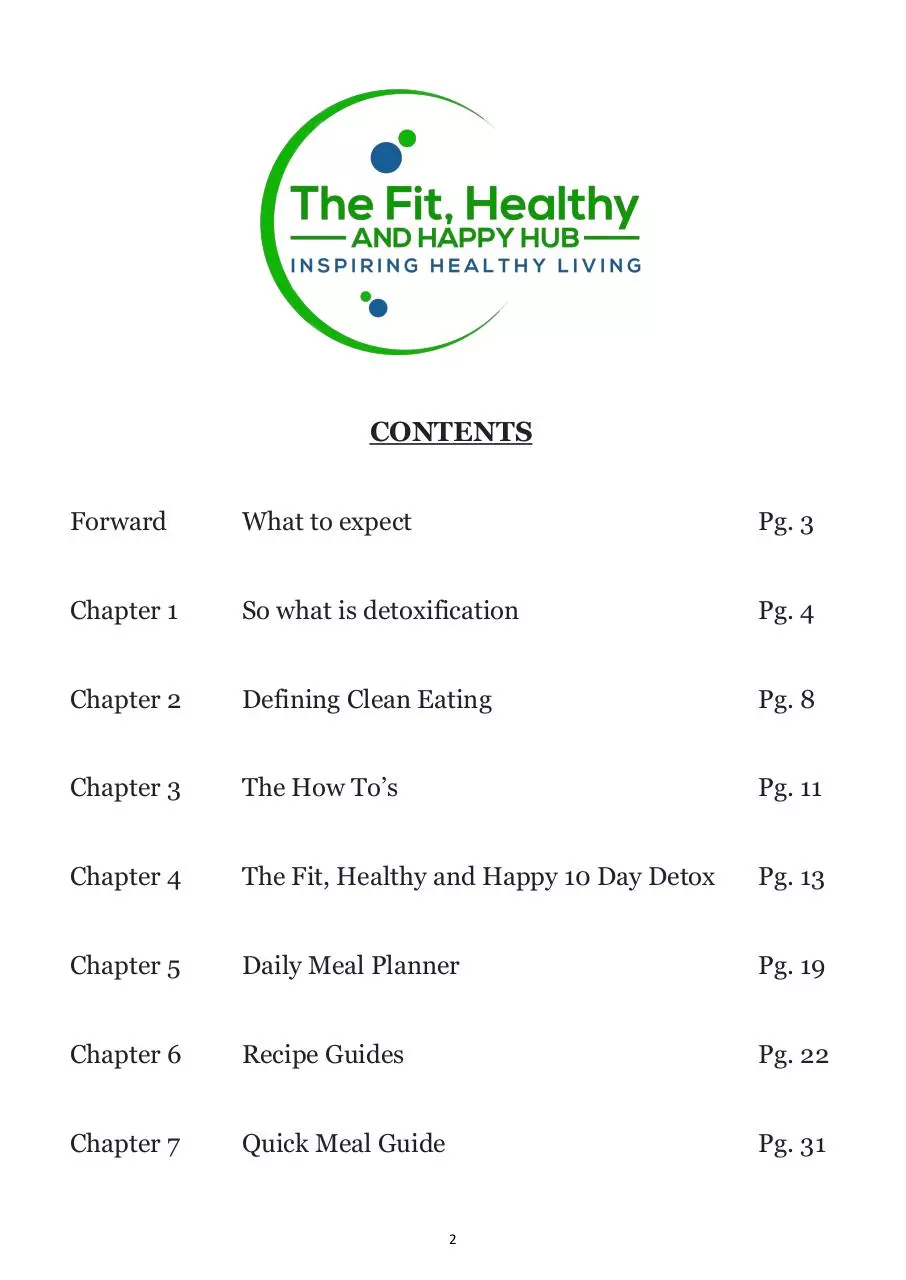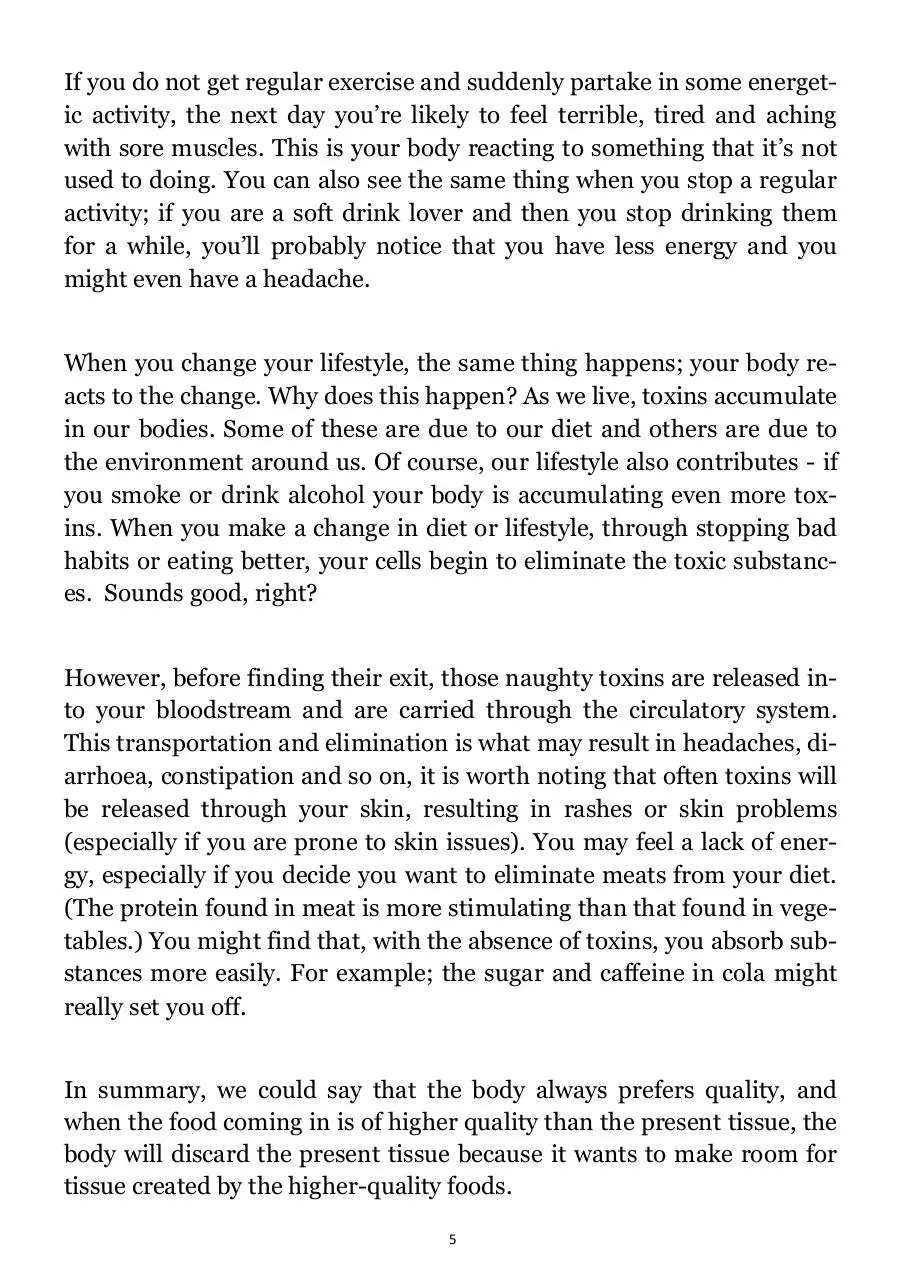Ebook (PDF)
File information
This PDF 1.5 document has been generated by , and has been sent on pdf-archive.com on 24/03/2018 at 19:53, from IP address 94.197.x.x.
The current document download page has been viewed 542 times.
File size: 1.51 MB (31 pages).
Privacy: public file





File preview
CONTENTS
Forward
What to expect
Pg. 3
Chapter 1
So what is detoxification
Pg. 4
Chapter 2
Defining Clean Eating
Pg. 8
Chapter 3
The How To’s
Pg. 11
Chapter 4
The Fit, Healthy and Happy 10 Day Detox
Pg. 13
Chapter 5
Daily Meal Planner
Pg. 19
Chapter 6
Recipe Guides
Pg. 22
Chapter 7
Quick Meal Guide
Pg. 31
2
FORWARD
Welcome to ‘10 DAY DETOX’ from ‘The Fit, Healthy and Happy Hub’.
What this book will help you do…
This Ebook will help you to have a better understanding of Clean Eating and
what detoxification is. It will also provide you with a 10 Day Detox eating
guide and corresponding recipes.
What this book won’t help you do…
It won’t help you if you were thinking by detoxing it meant that you would
be drinking nothing but water and juices. This Ebook is not about dieting or
starving yourself, it’s about changing your lifestyle and removing foods from
your diet that contain toxins.
Regular detoxing will help to strengthen your immune system’s function and
fight off infections. Toxins affect your body's natural ability to burn fat, leading to weight gain. ... Detoxing will rid the body of toxins stored in fat cells
and increase your metabolism.
As it says on the cover, this programme is ‘Clean, Green and Gets You Lean.
Remember guys, nothing tastes as good as Fit, Healthy and Happy feels.
3
Chapter 1 - So what is detoxification?
This term is used to describe the process that your body undergoes to get rid
of toxins.
OK so what is a toxin?
Wikipedia states:
A toxin is a poisonous substance produced within living cells or organisms; synthetic toxicants created by artificial processes are thus excluded. The term was first used by organic
chemist Ludwig Brieger (1849–1919).
Toxins can be small molecules, peptides, or proteins that are capable of causing disease on
contact with or absorption by body tissues interacting with biological macromolecules such as
enzymes or cellular receptors. Toxins vary greatly in their toxicity, ranging from usually minor (such as a bee sting) to almost immediately deadly (such as botulinum toxin).
When you adjust your lifestyle by starting something new detoxification
symptoms are likely to occur, for example by changing your diet, by starting
exercising, or by stopping a current habit like consuming chocolate or caffeinated drinks.
Symptoms can be both mental and physical - they often include headaches,
stomach aches, coughs, colds, diarrhoea, skin rashes/acne, clogged sinuses
and fevers, as well as generally feeling run down and irritable.
These symptoms may last for a few days or they could last longer and cause
you considerable discomfort. These symptoms are the same as those that
show up in certain illnesses, changing your lifestyle can be confusing:
If I am doing something that is supposed to be good for me, why
do I have these symptoms? Why do I feel worse, and not better?
Understanding this apparent contradiction is perhaps the first, and most important hurdle you must get over when making your lifestyle change. If you
consider this contradiction carefully, think of how you might already have
experienced this on a short-term basis...
4
If you do not get regular exercise and suddenly partake in some energetic activity, the next day you’re likely to feel terrible, tired and aching
with sore muscles. This is your body reacting to something that it’s not
used to doing. You can also see the same thing when you stop a regular
activity; if you are a soft drink lover and then you stop drinking them
for a while, you’ll probably notice that you have less energy and you
might even have a headache.
When you change your lifestyle, the same thing happens; your body reacts to the change. Why does this happen? As we live, toxins accumulate
in our bodies. Some of these are due to our diet and others are due to
the environment around us. Of course, our lifestyle also contributes - if
you smoke or drink alcohol your body is accumulating even more toxins. When you make a change in diet or lifestyle, through stopping bad
habits or eating better, your cells begin to eliminate the toxic substances. Sounds good, right?
However, before finding their exit, those naughty toxins are released into your bloodstream and are carried through the circulatory system.
This transportation and elimination is what may result in headaches, diarrhoea, constipation and so on, it is worth noting that often toxins will
be released through your skin, resulting in rashes or skin problems
(especially if you are prone to skin issues). You may feel a lack of energy, especially if you decide you want to eliminate meats from your diet.
(The protein found in meat is more stimulating than that found in vegetables.) You might find that, with the absence of toxins, you absorb substances more easily. For example; the sugar and caffeine in cola might
really set you off.
In summary, we could say that the body always prefers quality, and
when the food coming in is of higher quality than the present tissue, the
body will discard the present tissue because it wants to make room for
tissue created by the higher-quality foods.
5
How severe are the symptoms and how long do they last?
How long your symptoms last and how severe they are depend on your starting point prior to making the lifestyle change, also how quickly you make that
change.
If you have a diet heavy in red meats, for example, and overnight became a
vegan, you might have severe symptoms for a period of time. If your lifestyle
changes are more gradual, the symptoms are likely to be less severe. The duration of the symptoms may not be linear; there is a chance that they’ll come
in cycles. You might feel great at first and then experience some detoxification
symptoms. After the initial toxins are flooded out of your body, you will feel
good again, however, the body "goes deeper" and finds more toxins to eliminate; these symptoms may reappear, and after toxins are further reduced, you
will feel even better still. As you progress, you’ll find that the duration of
symptoms gets shorter and the period of well-being greater.
What am I supposed to do during this time?
The hardest thing for most people, is accept that they are not sick and realise
that their body is cleansing itself. Once you get beyond this psychological barrier, the rest is easy. The most important thing to do can be summed up in
one word: Rest. Rest, and let the body do what it needs to. If you have the luxury of staying home, do so! If not, cut back on your social engagements and
perhaps even cut back on any exercise you are getting. Give your body as
much energy as possible to do its jobs. Eat light foods that are easy to digest consume fruits and vegetables and drink plenty of water.
Summary Possible Detoxification Symptoms:
Skin Rashes, Blocked Pores & Acne Eruptions
Constipation, Diarrhoea & Flatulence
Stomach Ache
Cough, Cold & Fever Symptoms
Headache
Moodiness & Irritability
Fatigue
6
But please stick with it though; believe me it’s worth it…
You will get to the stage where your body returns to its natural state
where it knows when you are consuming toxins.
My real life example >>
The other day I had a moment of weakness in the supermarket when I
was hungry and tired after a really long shift at my office, they didn’t
have what I wanted to buy.
Then right there before me like a gift from the gods I saw a Double
Chocolate Cheesecake with chocolate brownie chunks, marshmallows
and toffee sauce, it looked amazing and even better… it was in the reduced fridge - my hunger weakened mind decided I needed it!
I knew before buying it, that it would make me feel rotten but still I
bought it! Well after only a few mouthfuls I started to get a headache, I
persevered and proceeded to trough my way through ¾ of it. This resulted in me having a headache and stomach for about 3 hours until I
went to bed.
The conclusion was that my body is not used to eating all that sugar and
whatever various chemicals were in there to keep it ‘fresh’ for a few
weeks.
After that binge I certainly felt like I needed to get back on the detox…
Our way to detoxify our bodies is to follow a clean eating program; this
means that we are going to eliminate certain foods from our diet to help
us achieve this.
Next you will read a bit more about ‘Clean Eating’.
7
Chapter 2 - Defining Clean Eating
Clean eating is a deceptively simple concept. Rather than revolving
around the idea of changing the amounts of certain things that we eat, it
is more about being mindful of the food's journey between its origin and
you consuming it.
Simplified, clean eating is about eating whole or "real" foods — those
that are un-processed or minimally refined and handled, allowing them
to be as close to their natural form as possible. Modern-day food production is now so sophisticated that consuming whole foods can be a challenging proposition in itself.
What Counts as Processed Foods?
The definition of processed food
"Processing" includes:
•Any food products with components manufactured in a laboratory. If
the ingredients list has things you can't recognise or even pronounce,
that's a pretty good indication that it's not natural (so you shouldn’t be
eating it).
•Changing the form of the natural food — eg, removing the germ and
bran from whole grains to make refined bread, pulping apples into apple
sauce, or cooking vegetables.
• Any kind of additions — that includes salt, sugar and fat added for flavour, to preservatives that keep food from going off (food is supposed to
go off), to the vitamins used to enrich everything from drinks to breakfast cereals.
So bearing this in mind, processed foods include everything from hot
dogs to jars of organic pasta sauce and quick-cook porridge.
8
Why is processing so bad, even if it's something as simple as
adding heat?
Categorically speaking it’s not.
Processing is not always bad, often processing removes toxins or bacteria, or allows for us to eat certain types of foods in off-season due to
freezing or canning. Processing also includes altering the taste or consistency of food to make it more appetizing.
So that delicious post-workout spinach & banana smoothie you had? It
was somewhat processed…
Despite the fact that pasteurised milk, spinach smoothies, and quickcook porridge are all processed, it doesn't put them on par with doughnuts and cola.
The key is to avoid foods that are 'ultra-processed’, that’s anything ready
-to-heat or factory made to resemble food (ie, reconstituted meats)
A lot of meats that are on offer in the supermarket are heavily processed
and have been reformed to look like meat from meat slurry.
Wikipedia quote time:
A meat slurry, reconstituted meat, or emulsified meat is a liquefied meat product that contains
fewer fats, pigments and less myoglobin than unprocessed dark meats. Meat slurry is more
malleable than dark meats and eases the process of meat distribution as pipelines may be used.
Meat slurry is not designed to sell for general consumption; rather, it is used as a meat supplement in food products for humans, such as chicken nuggets, and food for domestic animals.
Poultry is the most common meat slurry, however, beef and pork are also used.
Nice, eh?
9
Download Ebook
Ebook.pdf (PDF, 1.51 MB)
Download PDF
Share this file on social networks
Link to this page
Permanent link
Use the permanent link to the download page to share your document on Facebook, Twitter, LinkedIn, or directly with a contact by e-Mail, Messenger, Whatsapp, Line..
Short link
Use the short link to share your document on Twitter or by text message (SMS)
HTML Code
Copy the following HTML code to share your document on a Website or Blog
QR Code to this page

This file has been shared publicly by a user of PDF Archive.
Document ID: 0000748952.